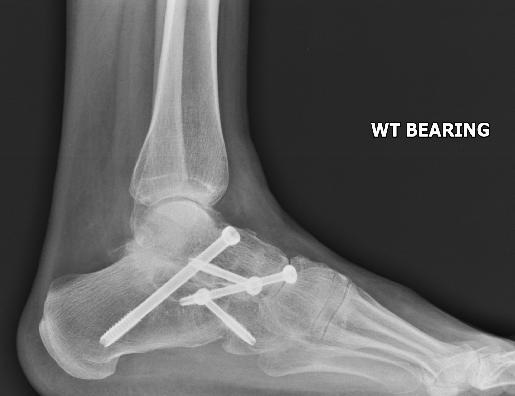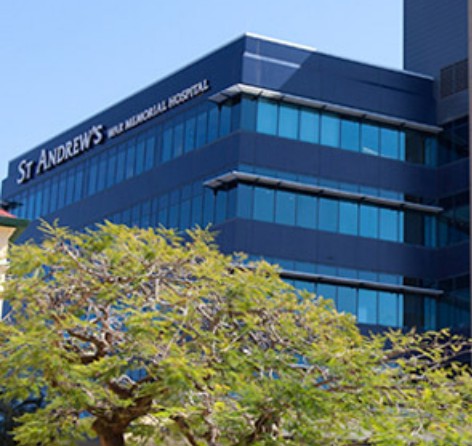- 1300 478 375
This is an operation to “fuse” or stiffen the three main joints of the back part of the foot (hence “triple fusion”). Triple fusions are done for two main reasons:
arthritis of the joints, because of a previous injury that has damaged the joints, a generalised condition such as osteoarthritis or rheumatoid arthritis, or because the joint is just wearing out for some other reason
severe deformity of the foot, such as a flat foot, high-arched or “cavus” foot, a club foot or other deformity. Sometimes these can be corrected by breaking and reshaping the bones, but in other cases it is best to stiffen the joints in the corrected position, particularly if the joints are already stiff or the foot is weak.
If the damage or deformity is limited to one or two of the foot joints it may be possible to treat it by a more limited operation. However, as these joints work together, damage to one is often accompanied by damage to others.
We often inject local anaesthetic or steroid into damaged joints, before any surgery is considered, to see whether this helps the pain. In some people, this gets rid of the pain and surgery is not necessary. In others, pain relief does not last but the results of the injection helps us to decide which joints to fuse

Two cuts are made, one along the outer side of the foot and one on the inner side. Usually these are 4-5 cm long. Each of the three joints is opened up and the joint surfaces removed and, if necessary, reshaped to correct a deformity. The joints are then put in the correct place and fixed together with screws, pins or staples.
It is usually necessary to put some extra bone into a triple fusion to get it to heal and to fill any gaps in the fusion left by correcting deformity. Often this extra bone has to be taken from the shin or the pelvis just above the hip.
Some people who have foot deformities have a tight Achilles tendon (“heel cord”) or weak muscles, or both. The Achilles tendon may be lengthened during surgery by making three small cuts in the calf and stretching the tendon.
Most people who are reasonably fit can come into hospital on the day of surgery. After surgery your foot will tend to swell up quite a lot. You will therefore have to rest with your foot raised to help the swelling to go down. This may take anything from 24 hours to a week. If you get up too quickly this may cause problems with the healing of your foot.
Once the swelling goes down and the cuts on your foot are healing your foot will be put in plaster and you can get up with crutches and go home. The physiotherapist will teach you how to walk with crutches. We will get you up as soon as possible. Most people are in hospital for 3-4 days.
The operation is usually done under general anaesthetic (asleep). Alternatively, an injection in the back, leg or around the ankle can be done to make the foot numb while the patient remains awake. Local anaesthetic injections do not always work and in that case you may have to go to sleep if the operation is to be done. Your anaesthetist will advise you about the best choice of anaesthetic for you.
In addition, local anaesthetic may be injected into your leg or foot while you are asleep to reduce the pain after the operation even if you go to sleep for the surgery. You will also be given pain-killing tablets as required.
You will need to wear a plaster from your knee to your toes until the joints have fused – usually 8-10 weeks. For the first month you should not put any weight on your foot as it may disturb the healing joints. (Occasionally touching your foot to the ground for balance is OK, but no more.)
A plaster splint down the back of your ankle and under your foot will be applied while you are asleep. This is only a half-plaster, to allow for swelling. You will be provided with crutches when you are discharged from hospital, and a physiotherapist will teach you how to use these. You cannot put any weight through your plaster in the first two weeks. You can usually take some weight for balance once the wounds are healing well and the swelling is going down – usually about 10-14 days. It is very important that the leg remains elevated most of the time in the first 2 weeks. Do not wet or remove the plaster.
SWELLING – This can be minimised by elevating your foot above your heart; icing the foot may be helpful
PAIN – You will receive a prescription for pain medication on discharge from hospital. Pain can also be minimised by elevating your leg.
BLEEDING – This always occurs. You may notice some oozing through the bandages.
10-14 days after your operation you will be seen again by Dr. Sterling. Your plaster will be removed and the cut and swelling on your foot checked. If all is well you will be put into a walking boot. You should continue walking with your crutches.
About 8 weeks after your operation you will come back to for an x- ray. A few people’s bones are already almost healed at his point. If so, they may be able to start weightbearing in the walking boot.
You will have further x-rays over the next few weeks: exactly when and how often will be determined by how well your foot is healing. When the x-rays show that the joint is fused enough to take your weight, the boot will be removed and you can start walking without it.
As explained above, you should not walk in the foot for at least eight (8) weeks after surgery. Your surgeon will advise you when you can start taking some weight on the foot.
If your foot is comfortable, and you can keep your foot up and you can go back to work within 2-3 weeks of surgery. On the other hand, in a manual job with a lot of dirt or dust around and a lot of pressure on your foot, you may need to take anything up to six months off work. How long you are off will depend on where your job fits between these two extremes.
If you have only your left foot operated on and have an automatic car you can drive within a few weeks of the operation, when your foot is comfortable enough and you can bear weight through it. Most people prefer to wait till the plaster is removed and they can wear a shoe.
After your boot is removed you can start taking increasing exercise. Start with walking or cycling, building up to more vigorous exercise as comfort and flexibility permit. Obviously, the foot will be stiffer after surgery and you may not be able to do all you could before. However, many people find that because the foot is more comfortable than before surgery they can do more than they could before the operation. Most people can walk a reasonable distance on the flat, slopes and stairs, drive and cycle. Walking on rough ground is difficult after a triple fusion because the foot is stiffer. It is unusual to play vigorous sports such as squash or football after a triple fusion.
You may have moderate pain following the surgery and can take panadeine forte as provided or paracetamol The pain should lessen each day.
You should contact Dr Sterling (through the switchboard of the hospital where you had your surgery), or his secretary on 1300 478 375.
Whilst it is unlikely, if you feel extremely unwell, or there is an unexpected delay in finding Dr Sterling, attend the nearest Hospital Emergency Department.




Take the first step towards your treatment and book your initial appointment with our orthopaedic surgery team.
Prefer the phone? 1300 478 375


